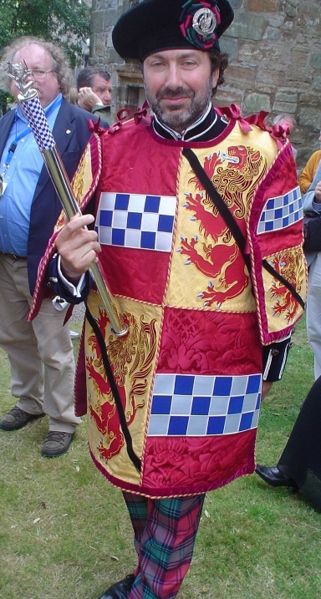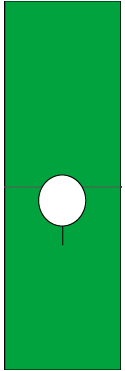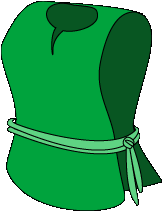Difference between revisions of "Tabard"
| Line 16: | Line 16: | ||
*A piece of heavy paper | *A piece of heavy paper | ||
| − | '''Step One''': | + | '''Step One''':[[Image:Tabard-3.gif|thumb|Step 2]] |
Lay flat the fabric on a table or the floor. Fold the fabric in half to find the middle. Mark the center line with the pencil, or press the fold with your hands until the fabric creases. | Lay flat the fabric on a table or the floor. Fold the fabric in half to find the middle. Mark the center line with the pencil, or press the fold with your hands until the fabric creases. | ||
| Line 22: | Line 22: | ||
'''Step Two''': | '''Step Two''': | ||
Unfold the fabric so it lays flat again. Draw out a circle on the fabric that is about 1/4 to 1/3 one one half of the fabric, and 3/4 to 2/3 on the other half. The circle should be about 8" in diameter, but may need to be adjusted for the size of your head. It may help to draw out the circle on the heavy paper first, then cut it out and trace it on the fabric. | Unfold the fabric so it lays flat again. Draw out a circle on the fabric that is about 1/4 to 1/3 one one half of the fabric, and 3/4 to 2/3 on the other half. The circle should be about 8" in diameter, but may need to be adjusted for the size of your head. It may help to draw out the circle on the heavy paper first, then cut it out and trace it on the fabric. | ||
| − | + | ||
'''Step Three''': | '''Step Three''': | ||
Revision as of 07:59, 5 November 2008
A type of garb Similar to a tunic but with open sides and is generally without sleeves. Tabards can be used to incorporate company, household, and/or individual colors.

A tabard is a short coat, either sleeveless, or with short sleeves or shoulder pieces, which was a common item of men's clothing in the Middle Ages, usually for outdoors. It might be belted, or not. Tabards might be emblazoned on the front and back with a coat of arms, and in this form they survive now as the distinctive garment of officers of arms in heraldry.
From the French tabarde; was originally a humble outer garment of tunic form, generally without sleeves, worn by peasants, monks and foot-soldiers, including Chaucer's ploughman. In this sense the first OED citation is 1300. See also The Tabard, the inn at which the principals meet in that same Prologue. (Wikisource:The Canterbury Tales: General Prologue) In the late middle ages tabards, now open at the sides and so usually belted, were worn by knights over their armour, and usually emblazoned with their arms (though sometimes worn plain). OED first records this use in English in 1450. In this meaning they were apparently distinguished from surcoats by being open at the side, and by being shorter. These became an important means of battlefield identification with the development of plate armor as the use of shields declined.
How too make a tabard
Making a tabard is quite simple, and a minimal amount of materials are needed. It is recommended that you either use a fabric that won't fray on the edges, or hem up the edges so they won't fray. This is the design for a very basic tabard. Much more elaborate and decorated tabards can be made by altering this pattern, but the basics remain the same.
Materials Needed:
- Fabric measuring 18" x 72"
- Scissors
- Measuring tape or ruler
- Pencil
- A piece of heavy paper
Step One:
Lay flat the fabric on a table or the floor. Fold the fabric in half to find the middle. Mark the center line with the pencil, or press the fold with your hands until the fabric creases.
Step Two:
Unfold the fabric so it lays flat again. Draw out a circle on the fabric that is about 1/4 to 1/3 one one half of the fabric, and 3/4 to 2/3 on the other half. The circle should be about 8" in diameter, but may need to be adjusted for the size of your head. It may help to draw out the circle on the heavy paper first, then cut it out and trace it on the fabric.
Step Three:
Fold the fabric in half the short way and make a small mark along the center coming down off the circle. The mark should be about three inches in length.
Step Four:
Cut out the circle that you have drawn. Then cut down along the center line that you drew in step three. Your head should fit easily through the hole you have just created.
Step Five:
Put the tabard on with the slit down the front. The bottom edges should line up nicely, but if they're a little off, it's okay. Tie a sash or belt around your waist on the outside of the tabard and you're ready to go!
While the above will teach you how to make a very very basic tabard, please look further into this how to by Vaargard. Hemming the seams and adding decoration can take you from a bedspread to a kingly raiment.
Tabards of Fighting Companies:
- Saracens - Red and Black
- Peregrine Guard - Purple and Black
- Ferrum Crux - Green, Blue and Grey
- Grendel Company Black and gold/yellow

